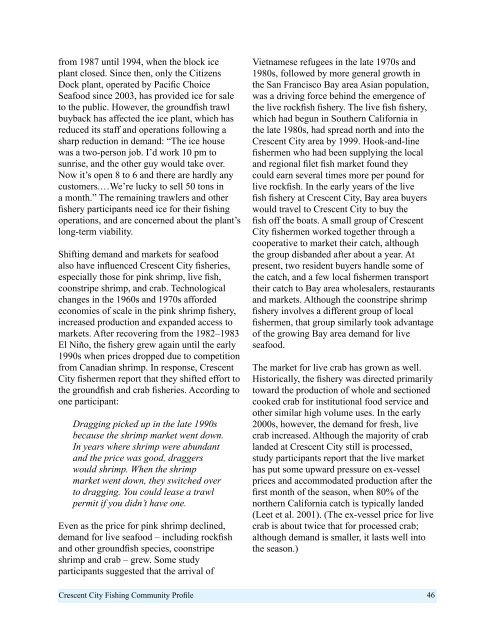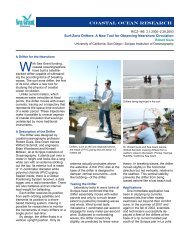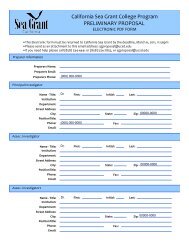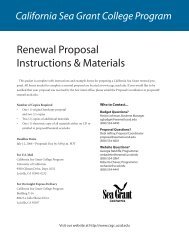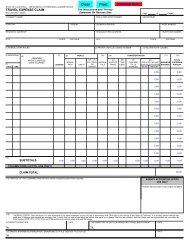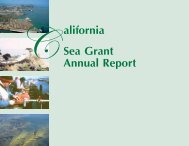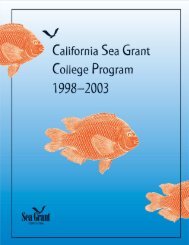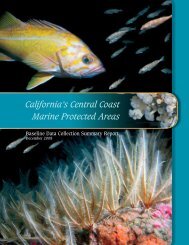Crescent City Profile - California Sea Grant
Crescent City Profile - California Sea Grant
Crescent City Profile - California Sea Grant
- No tags were found...
You also want an ePaper? Increase the reach of your titles
YUMPU automatically turns print PDFs into web optimized ePapers that Google loves.
from 1987 until 1994, when the block iceplant closed. Since then, only the CitizensDock plant, operated by Pacific Choice<strong>Sea</strong>food since 2003, has provided ice for saleto the public. However, the groundfish trawlbuyback has affected the ice plant, which hasreduced its staff and operations following asharp reduction in demand: “The ice housewas a two-person job. I’d work 10 pm tosunrise, and the other guy would take over.Now it’s open 8 to 6 and there are hardly anycustomers.…We’re lucky to sell 50 tons ina month.” The remaining trawlers and otherfishery participants need ice for their fishingoperations, and are concerned about the plant’slong-term viability.Shifting demand and markets for seafoodalso have influenced <strong>Crescent</strong> <strong>City</strong> fisheries,especially those for pink shrimp, live fish,coonstripe shrimp, and crab. Technologicalchanges in the 1960s and 1970s affordedeconomies of scale in the pink shrimp fishery,increased production and expanded access tomarkets. After recovering from the 1982–1983El Niño, the fishery grew again until the early1990s when prices dropped due to competitionfrom Canadian shrimp. In response, <strong>Crescent</strong><strong>City</strong> fishermen report that they shifted effort tothe groundfish and crab fisheries. According toone participant:Dragging picked up in the late 1990sbecause the shrimp market went down.In years where shrimp were abundantand the price was good, draggerswould shrimp. When the shrimpmarket went down, they switched overto dragging. You could lease a trawlpermit if you didn’t have one.Even as the price for pink shrimp declined,demand for live seafood – including rockfishand other groundfish species, coonstripeshrimp and crab – grew. Some studyparticipants suggested that the arrival ofVietnamese refugees in the late 1970s and1980s, followed by more general growth inthe San Francisco Bay area Asian population,was a driving force behind the emergence ofthe live rockfish fishery. The live fish fishery,which had begun in Southern <strong>California</strong> inthe late 1980s, had spread north and into the<strong>Crescent</strong> <strong>City</strong> area by 1999. Hook-and-linefishermen who had been supplying the localand regional filet fish market found theycould earn several times more per pound forlive rockfish. In the early years of the livefish fishery at <strong>Crescent</strong> <strong>City</strong>, Bay area buyerswould travel to <strong>Crescent</strong> <strong>City</strong> to buy thefish off the boats. A small group of <strong>Crescent</strong><strong>City</strong> fishermen worked together through acooperative to market their catch, althoughthe group disbanded after about a year. Atpresent, two resident buyers handle some ofthe catch, and a few local fishermen transporttheir catch to Bay area wholesalers, restaurantsand markets. Although the coonstripe shrimpfishery involves a different group of localfishermen, that group similarly took advantageof the growing Bay area demand for liveseafood.The market for live crab has grown as well.Historically, the fishery was directed primarilytoward the production of whole and sectionedcooked crab for institutional food service andother similar high volume uses. In the early2000s, however, the demand for fresh, livecrab increased. Although the majority of crablanded at <strong>Crescent</strong> <strong>City</strong> still is processed,study participants report that the live markethas put some upward pressure on ex-vesselprices and accommodated production after thefirst month of the season, when 80% of thenorthern <strong>California</strong> catch is typically landed(Leet et al. 2001). (The ex-vessel price for livecrab is about twice that for processed crab;although demand is smaller, it lasts well intothe season.)<strong>Crescent</strong> <strong>City</strong> Fishing Community <strong>Profile</strong> 46


